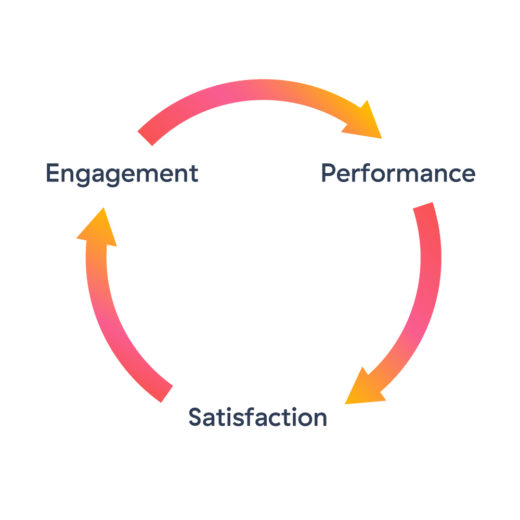What only managers can do to keep employees engaged

Prior to the industrial revolution, “work” was an activity that took place in fields and farmhouses. Then automated production moved an entire generation of workers from homesteads to factories. This was no easy commute; it was a paradigm shift. The former farmers became the first to experience the most enduring innovation of this era: the workplace.
It wasn’t love at first job-site. This was the empire of the foreman and workers had little rights. In this era of prolonged work shifts and poor labor conditions, a concept like “employee engagement” would have been pure science fiction.
Today, workers have more freedom to choose the kind of work they do, and demand a workplace that keeps them engaged. Is your workplace up to the challenge? Chances are, it’s not.
Who’s in charge?
According to Gallup’s State of the American Workplace report, less than a third of American workers are engaged at work. But the ROI of engaged workers is tremendous:
These employees willingly go the extra mile because of their strong emotional connection to their organization. Reaching this unique state goes beyond having a merely satisfactory experience at work to one of 100% psychological commitment.
Research suggests that the wrong people have been in charge of motivating workers. For decades, employee engagement has been in the domain of Human Resources, but companies are increasingly entrusting their managers to be the agents of change. Gallup finds that “managers account for at least 70% of variance in employee engagement” when measuring across business units. A 2013 study by Bain & Company supports this thesis:
Typically, HR groups rely on long, corporate-wide annual surveys and one-size-fits-all processes that focus on adherence, rather than encouraging changes tailored to the team level.
The studies prescribe a business- and manager-led, rather than HR-led, approach. This makes sense. Because of the close working relationship, a manager is uniquely positioned to identify when one of their employees is disengaged; they also have the power to really reach out and get that employee back on track.
The first definition of employee engagement
The earliest formal definition of employee engagement is in a paper by William Kahn called “Psychological conditions of personal engagement and disengagement at work.” Kahn defines engagement as: “[the] harnessing of organization members’ selves to their work roles; in engagement, people employ and express themselves physically, cognitively, and emotionally.”
The key word in that definition is “express”; employee engagement is a form of expression at work that lets employees bring a truer version of themselves to the workplace—one that requires less energy to construct and to perform (in a sense) for their peers.
The paper outlines three characteristics, or psychological conditions, required to foster engagement and employee motivation at work. These are meaningfulness, safety, and availability.
Meaningfulness is the condition of a workplace enables workers to feel useful, worthwhile, and valued. Work feels meaningful when workers have the autonomy to tackle rich and complex problems and there is clear delineation on procedures and goals.
Safety means workers are comfortable (and thus able) to “show and employ one’s self” without fear of being shot down or ridiculed. It is a trustworthy and secure environment. This usually happens when workers have strong interpersonal relationships at work.
Availability is having the physical, emotional, and psychological resources to bring your full self to work. This can manifest in two ways: 1) empowering your employees in their roles and 2) removing the distractions of social systems (bureaucracy, too many meetings, etc.) or physical blockers like fatigue.
Because of the close working relationship, a manager is uniquely positioned to identify when one of their employees is disengaged; they also have the power to get someone back on track.
Employee engagement is not the same as employee satisfaction, though they are related. Satisfaction refers to the level of happiness or contentment experienced at work. Nor is it the same as employee performance—how effective you are at your job—because, even a top producing worker can be disengaged.
Engagement is different because it requires self-direction and intent. Engaged employees bring a strong sense of personal motivation and emotional commitment to the work. Robert Kegan and Lisa Lahey, coauthors of How the Way We Talk Can Change the Way We Work, describe it as being “your whole self” at work. It’s the discretionary effort employees bring to the workplace. It’s the “above” and the “beyond.”
What managers (and only managers) can do
It’s possible for employees to be satisfied or top performers without being engaged. But engagement is a driver of both job satisfaction and job performance. Improving employee engagement almost always contributes to improved performance and job satisfaction.

Here is how you can improve employee engagement on your team.
Meaningfulness
You must help your reports understand how their daily work contributes to the organization as a whole. Individual contributors and front-line staff (like customer service and sales) are among the least engaged employees, and this is troubling; the attitude of these employees may have a direct impact on how your brand is perceived by the public. Take the time to appreciate them and help them understand how their work fits into the bigger picture.
If your employees are struggling, providing real, thoughtful feedback can help them understand why they are doing what they’re doing. Even constructive feedback helps convey that you recognize their efforts as well as their results.
Safety
Create a safe space for your employees through listening and mentorship. In fact, mentorship can drive engagement in both directions; when you encourage two-way feedback your employees feel heard.
It’s the manager’s job to make employees feel comfortable sharing their goals and ambitions—so try to tap into what they really want to get out of life. Your employees have vastly different personality types, so managers must learn to accommodate these working styles instead of trying to change them. When you learn who your employees actually are, and find out what drives them, you can then provide avenues at work that keep them motivated.
Another way to make your team feel safe, is to be more like a learning organization. These environments allow employees to feel psychological safety, and can also help people form bonds and friendships at work.
Availability
We have written about the AoR model before, since it is one of the key components of employee autonomy. You can’t “push a rope,” as the saying goes, and you get the best results from people who make their own decisions and choose how to execute on the expectations placed upon them, rather than choosing for them.
Even if your company doesn’t use the AoR model, individuals still need goals. Is your team clear on what they are setting out to achieve each day? Giving them clear objectives to work toward will help focus their energy and provide a motivating force to give it their all at work.
| Meaningfulness | Safety | Availability | |
| Answer the question | How meaningful is this work to me? | How safe is it at work to be myself? | Am I empowered to do this work? |
| What employees need |
|
|
|
| What managers can provide |
|
|
|
Bonus: Celebrate!
Are we having fun yet? This isn’t one of Kahn’s conditions, but we think it’s important to celebrate individual efforts and keep work fun.
Rituals are an effective way to increase engagement and strengthen bonds on your team. Consider planned spontaneity as a way to shake things up, and make repetitive workflows more dynamic. And don’t forget to say thank you. It’s simple, but it works.
Set it, but don’t forget it
Employee engagement is a process, not a project. There are steps anyone can take to check in on a team’s morale, and monitor people for burnout, but only a manager has the ability to transform an environment to reflect the needs of individuals on their team. There is a great sense of power in that, and a sense of responsibility too.
The two keys in the manager’s toolbox are deceptively simple: curiosity and empathy. The curious manager asks more questions of their employees. Not just about deliverables, but about their process, their efforts, their frustrations, and their ambitions. And the empathetic manager devotes genuine effort in finding out about the real person behind the “employee” that shows up to work every day.
That’s ultimately what engagement is: removing the barriers that prevent us bringing our “whole selves” to work. From homestead to workplace, the less we have to transform who we really are on the commute to work, the better people we are on the way back home.
How does your manager keep you and your team engaged? For team leads: How do you keep your team engaged and motivated?
More Issues
